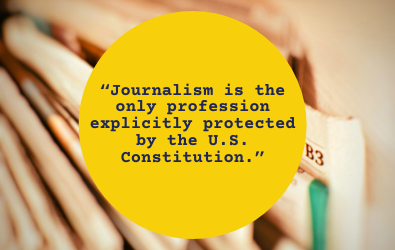As nonprofits know, for media outlets the COVID-19 pandemic has also been a time when the need for their services is rising but the financial resources necessary to provide them are rapidly disappearing.
COVID-19 is a news story that impacts everyone and crosses all demographics. Millions of people are sheltering in place and turning to news outlets for the latest information. According to the Wall Street Journal, CNN’s prime time ratings are more than double its ratings from the fourth quarter of 2019 and FOX News ratings are up nearly 50 percent since the end of last year.
However, the increased demand for news has not led to a healthier bottom line for media outlets. The advertisers they rely on for their revenue have less money to spend because of the downturn in business caused by COVID-19. The trend is endangering many local news outlets. The Boston Herald’s newsroom staff will take four week-long furlough periods over the next two and a half months. Northeastern Journalism Professor Dan Kennedy tweeted a memo that said several papers including the Eagle Tribune of North Andover and the Gloucester Daily Times will not put out a print edition on Tuesdays and Saturdays.
Understanding the media landscape can help you and your organization shape your media messaging strategy accordingly to elevate your profile and raise those hard to find donation dollars.
Know resources are limited
Bear in mind that members of the media are under stress, working long hours, and doing more with fewer resources. Reporters appreciate it when your materials are to the point and provide statistics. Keep your website updated with the latest on what you are doing to address the COVID-19 crisis, be flexible about timing when scheduling interviews, and have a Zoom friendly setting with good lighting ready to go for potential interviews.
Gather good visuals
An eye catching visual always gets attention. Visuals of family members seeing newborn babies for the first time through glass at North Shore Medical Center got attention on CNN as well as in local media. Taking creative photos and videos of what is happening can benefit both your media outreach and your own social media content.
Experts are in demand
If you have expertise in an area related to COVID-19, position yourself or a member of your leadership team as an expert. Whether it’s banking, medicine, or agriculture, let reporters know you have something to say about the pandemic. Opinion pieces and interviews with reporters establish you and your organization as important sources of information both during the pandemic and beyond.
People crave positive news
When you have positive news, share it. We can only take so much negative news. Some of the stories that have resonated much have been positive ones. The Washington Post has a newsletter called “The Optimist.” Massachusetts native John Krasinski’s “Some Good News” YouTube channel has gotten millions of views.
Be creative
Turn a negative into a positive by finding ways to keep your organization in the media conversation. Museums like the New England Aquarium and Isabella Stewart Gardner Museum have found virtual ways to share content with potential visitors even while their doors remain closed.
As bleak as things appear for the future of journalism, some alternative sources of financial support for struggling media outlets may be emerging. According to the Chronicle of Philanthropy, The American Journalism Project has raised $46 million to help the industry. Earlier this month, a group of journalism organizations led by Pen America, Free Press Action, and Common Cause sent a letter to congressional leaders asking for media outlets be included in future stimulus bills. The move was backed up by another letter urging support for the industry written by a group of 19 U.S. Senators including Sen. Richard Blumenthal of Connecticut and Senator Edward Markey of Massachusetts. If you are able, supporting local journalists by subscribing to their outlet is a way you can give back to an industry that is providing crucial information when we need it most. We are all in this together.


